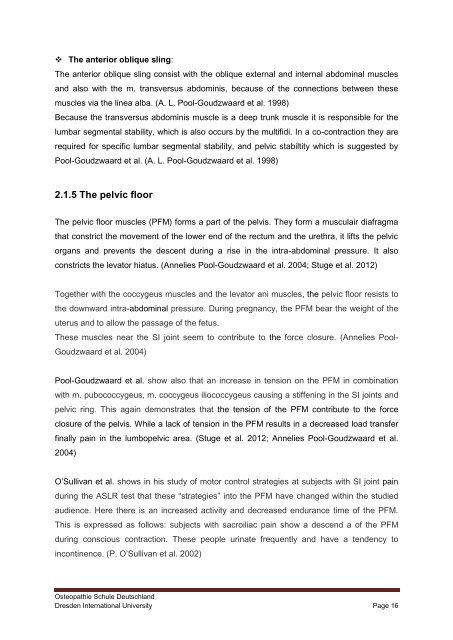Pelvic girdle pain and relevance of ASLR testing: A ... - Cindy Verheul
Pelvic girdle pain and relevance of ASLR testing: A ... - Cindy Verheul
Pelvic girdle pain and relevance of ASLR testing: A ... - Cindy Verheul
Create successful ePaper yourself
Turn your PDF publications into a flip-book with our unique Google optimized e-Paper software.
The anterior oblique sling:<br />
The anterior oblique sling consist with the oblique external <strong>and</strong> internal abdominal muscles<br />
<strong>and</strong> also with the m. transversus abdominis, because <strong>of</strong> the connections between these<br />
muscles via the linea alba. (A. L. Pool-Goudzwaard et al. 1998)<br />
Because the transversus abdominis muscle is a deep trunk muscle it is responsible for the<br />
lumbar segmental stability, which is also occurs by the multifidi. In a co-contraction they are<br />
required for specific lumbar segmental stability, <strong>and</strong> pelvic stabiltity which is suggested by<br />
Pool-Goudzwaard et al. (A. L. Pool-Goudzwaard et al. 1998)<br />
2.1.5 The pelvic floor<br />
The pelvic floor muscles (PFM) forms a part <strong>of</strong> the pelvis. They form a musculair diafragma<br />
that constrict the movement <strong>of</strong> the lower end <strong>of</strong> the rectum <strong>and</strong> the urethra, it lifts the pelvic<br />
organs <strong>and</strong> prevents the descent during a rise in the intra-abdominal pressure. It also<br />
constricts the levator hiatus. (Annelies Pool-Goudzwaard et al. 2004; Stuge et al. 2012)<br />
Together with the coccygeus muscles <strong>and</strong> the levator ani muscles, the pelvic floor resists to<br />
the downward intra-abdominal pressure. During pregnancy, the PFM bear the weight <strong>of</strong> the<br />
uterus <strong>and</strong> to allow the passage <strong>of</strong> the fetus.<br />
These muscles near the SI joint seem to contribute to the force closure. (Annelies Pool-<br />
Goudzwaard et al. 2004)<br />
Pool-Goudzwaard et al. show also that an increase in tension on the PFM in combination<br />
with m. pubococcygeus, m. coccygeus iliococcygeus causing a stiffening in the SI joints <strong>and</strong><br />
pelvic ring. This again demonstrates that the tension <strong>of</strong> the PFM contribute to the force<br />
closure <strong>of</strong> the pelvis. While a lack <strong>of</strong> tension in the PFM results in a decreased load transfer<br />
finally <strong>pain</strong> in the lumbopelvic area. (Stuge et al. 2012; Annelies Pool-Goudzwaard et al.<br />
2004)<br />
O’Sullivan et al. shows in his study <strong>of</strong> motor control strategies at subjects with SI joint <strong>pain</strong><br />
during the <strong>ASLR</strong> test that these “strategies” into the PFM have changed within the studied<br />
audience. Here there is an increased activity <strong>and</strong> decreased endurance time <strong>of</strong> the PFM.<br />
This is expressed as follows: subjects with sacroiliac <strong>pain</strong> show a descend a <strong>of</strong> the PFM<br />
during conscious contraction. These people urinate frequently <strong>and</strong> have a tendency to<br />
incontinence. (P. O’Sullivan et al. 2002)<br />
Osteopathie Schule Deutschl<strong>and</strong><br />
Dresden International University Page 16


